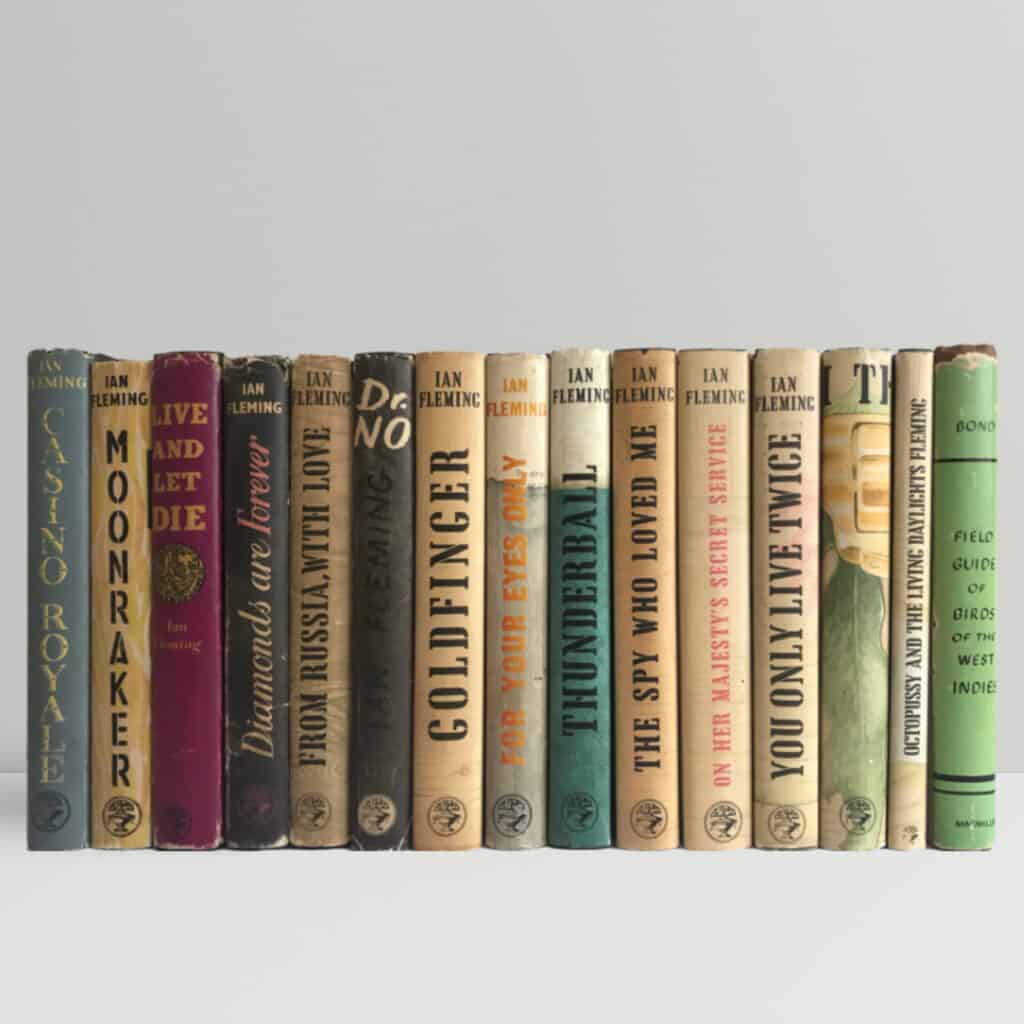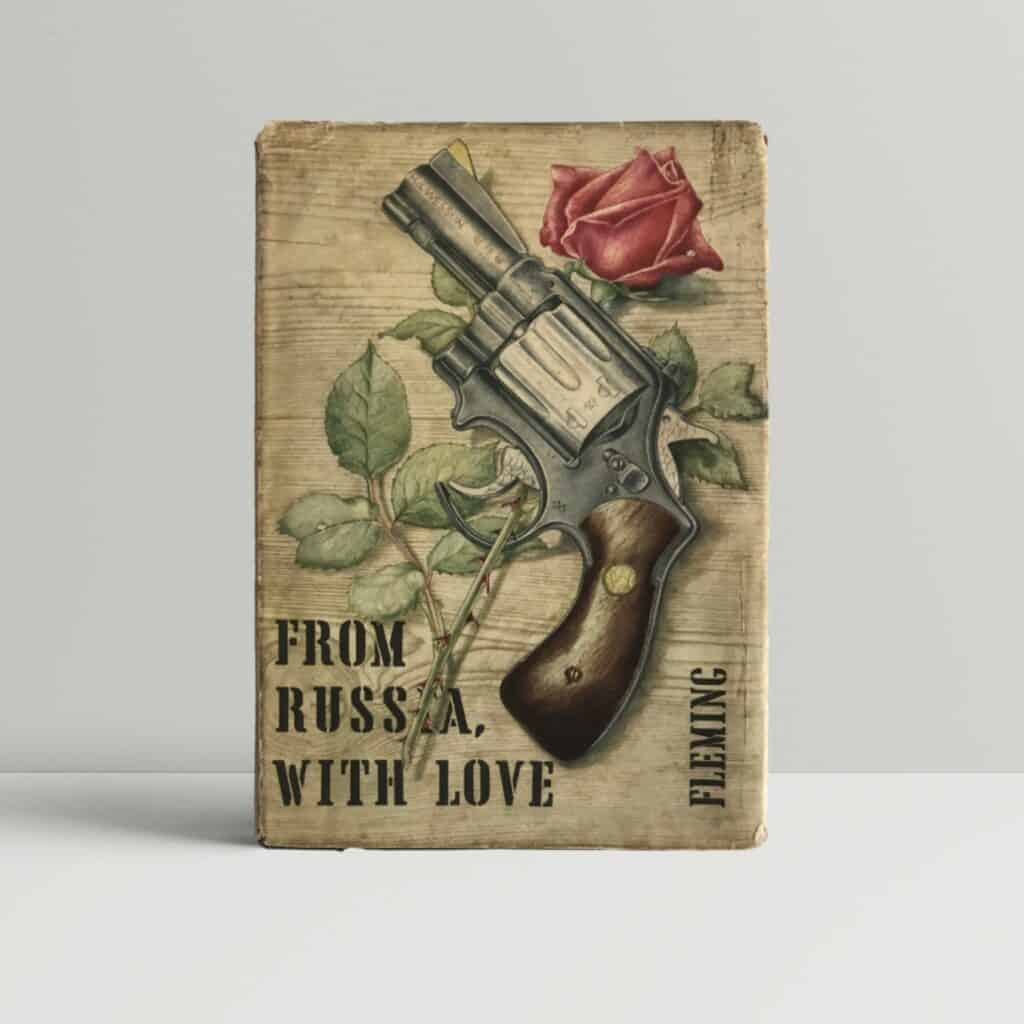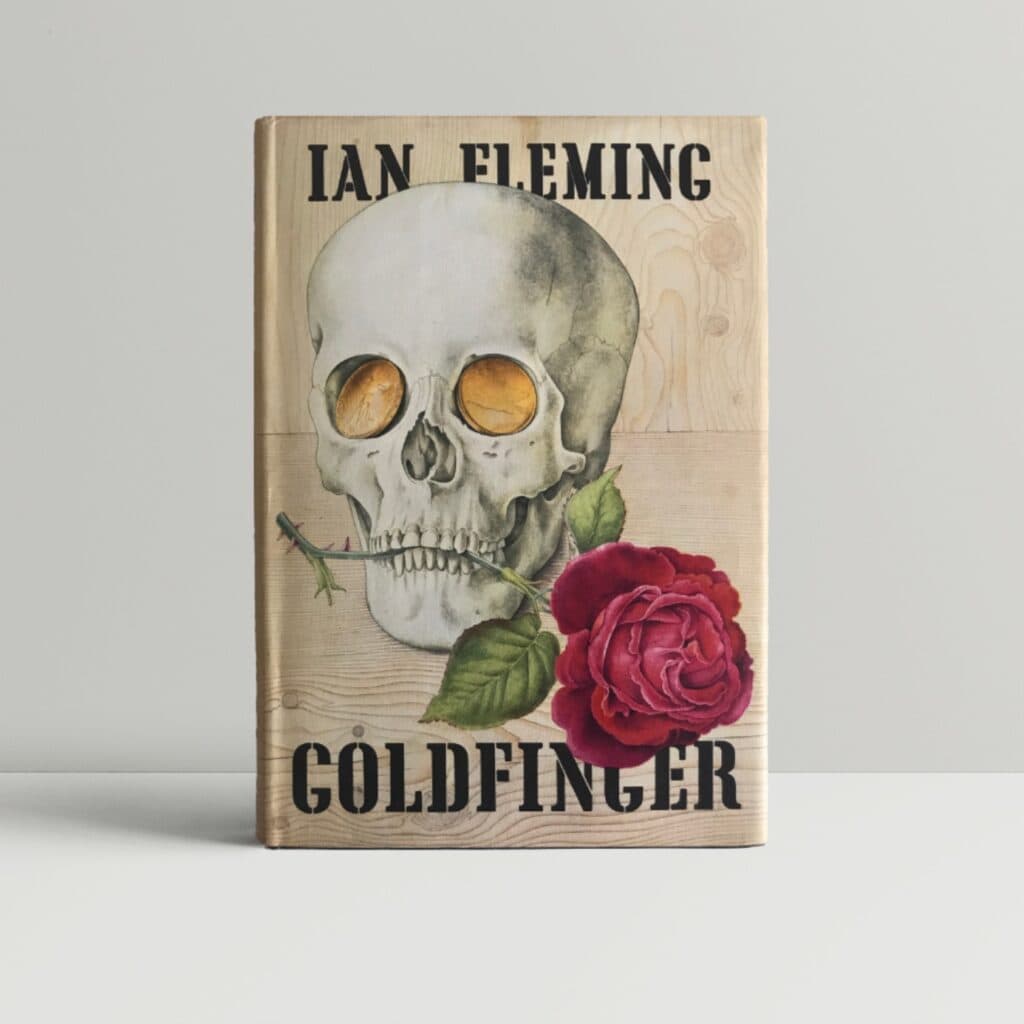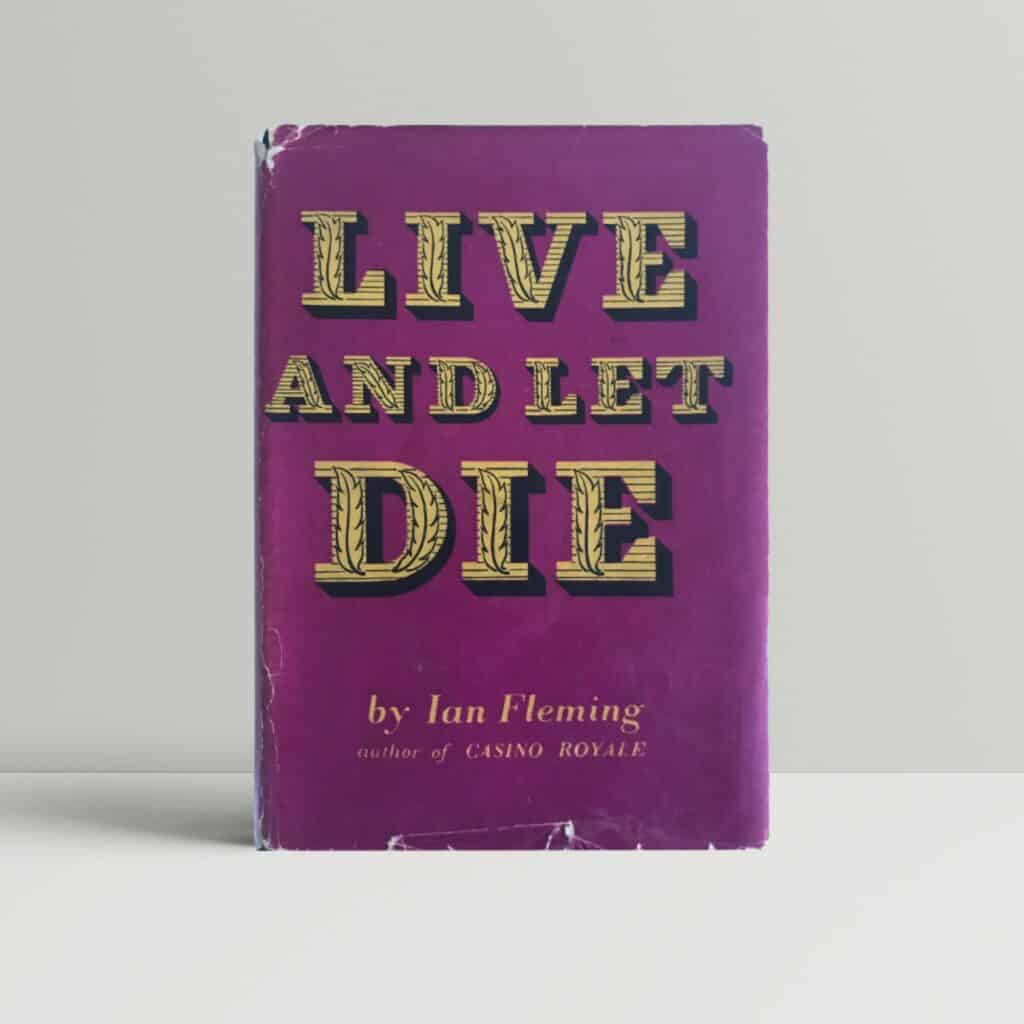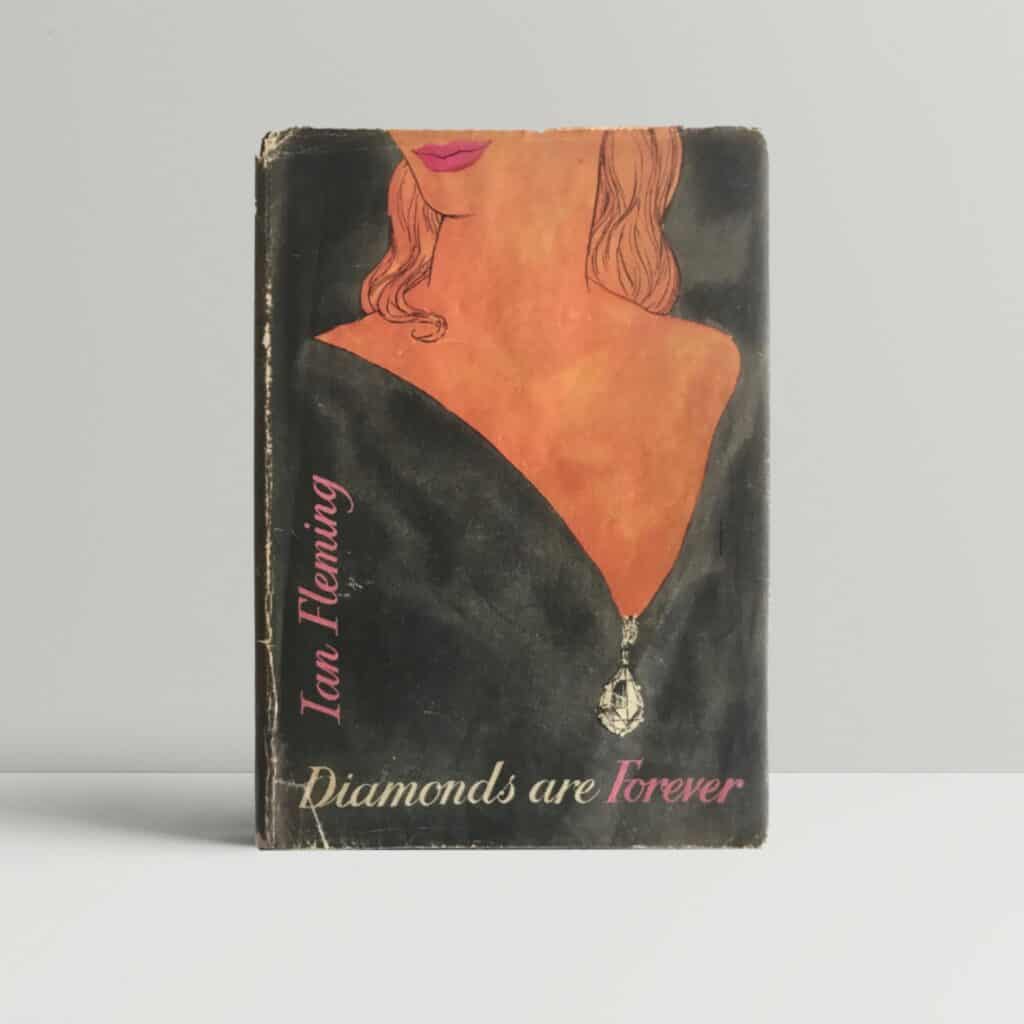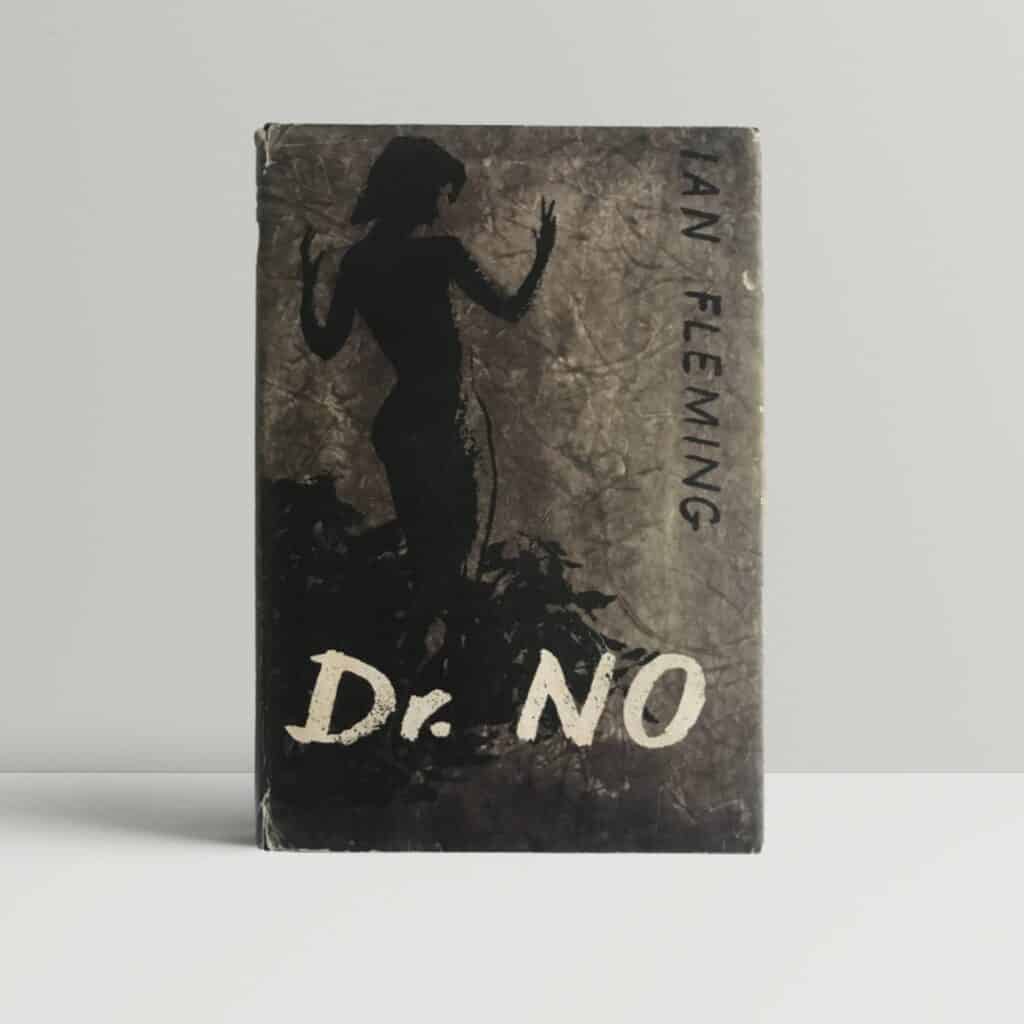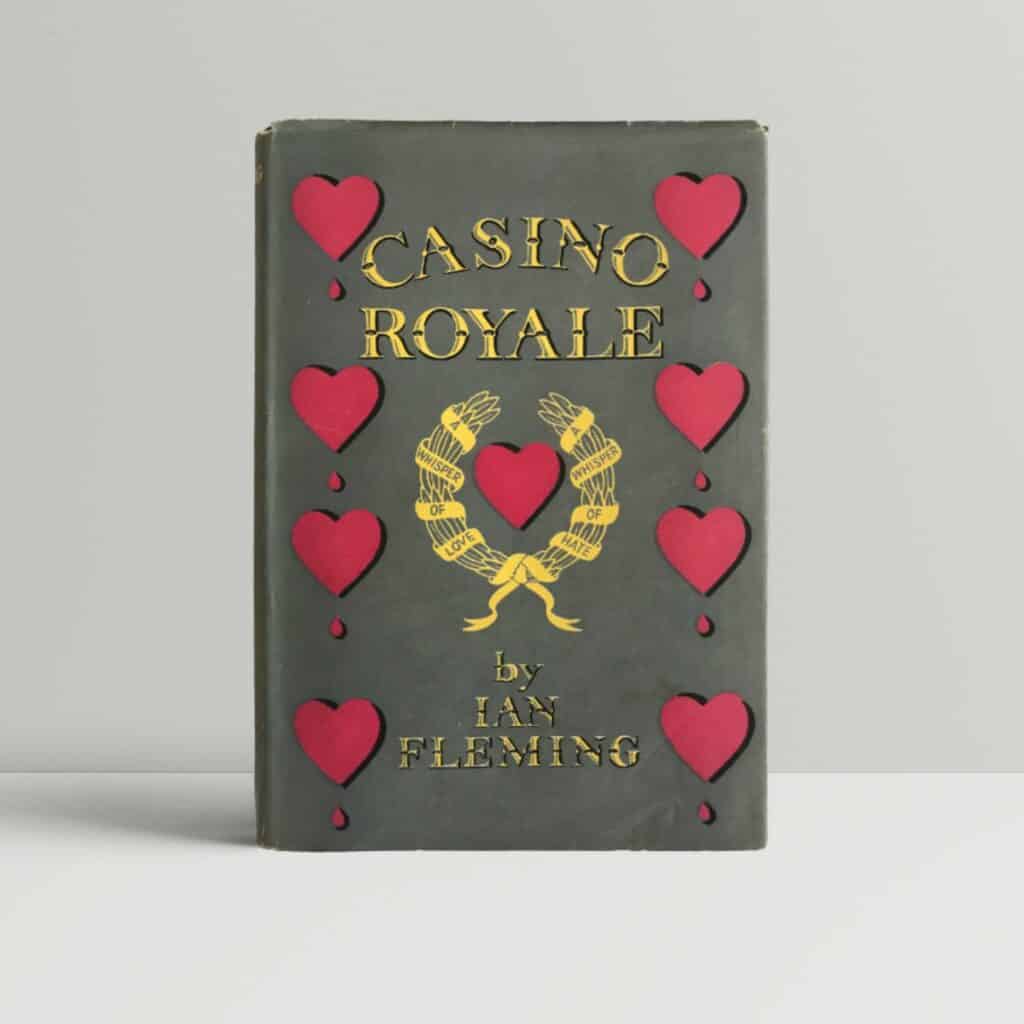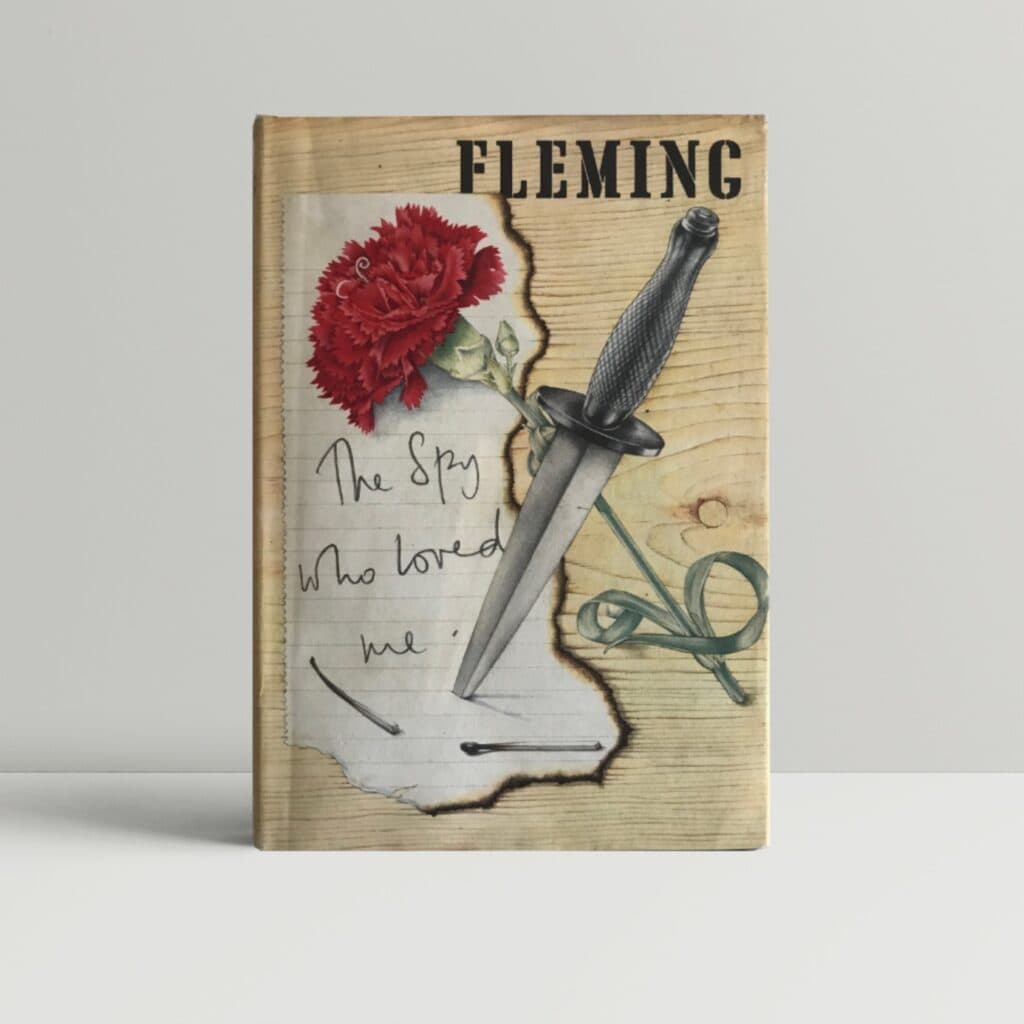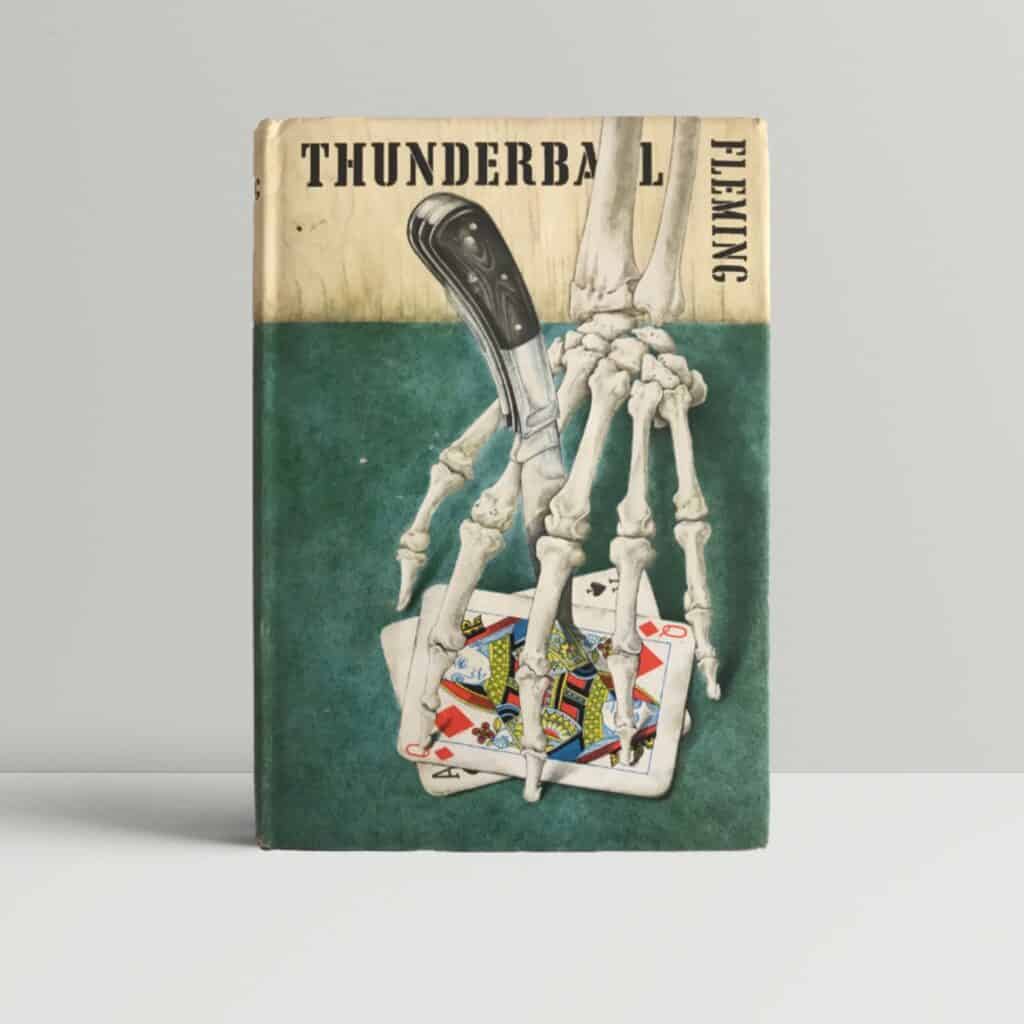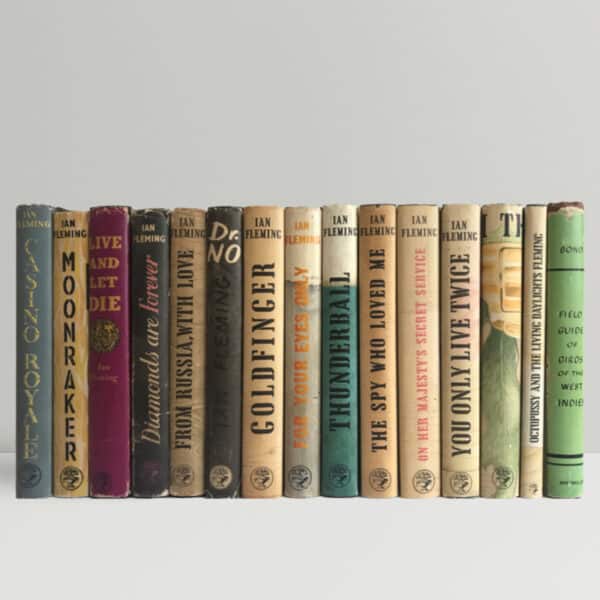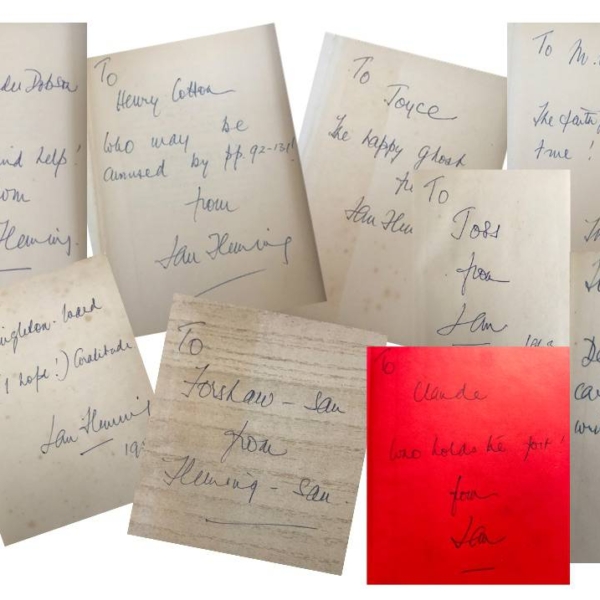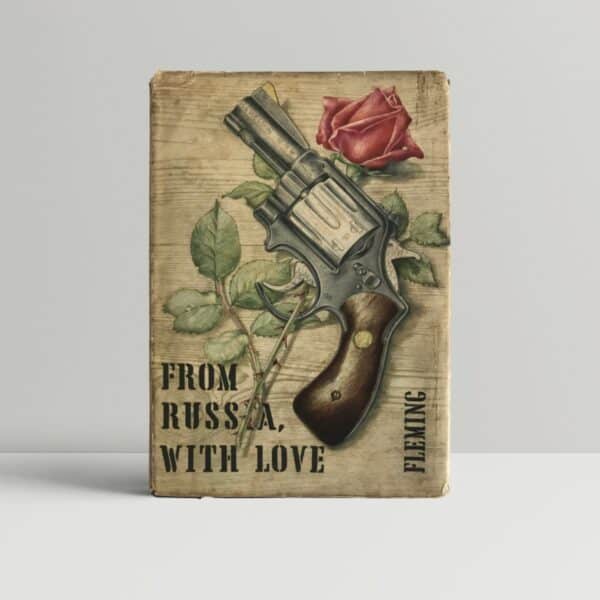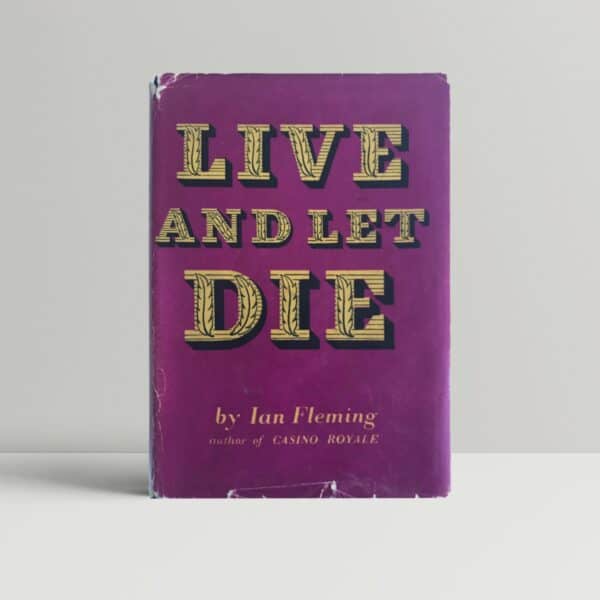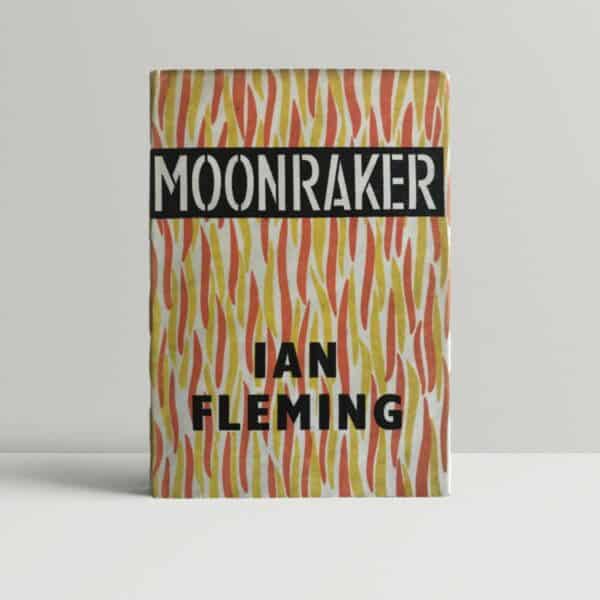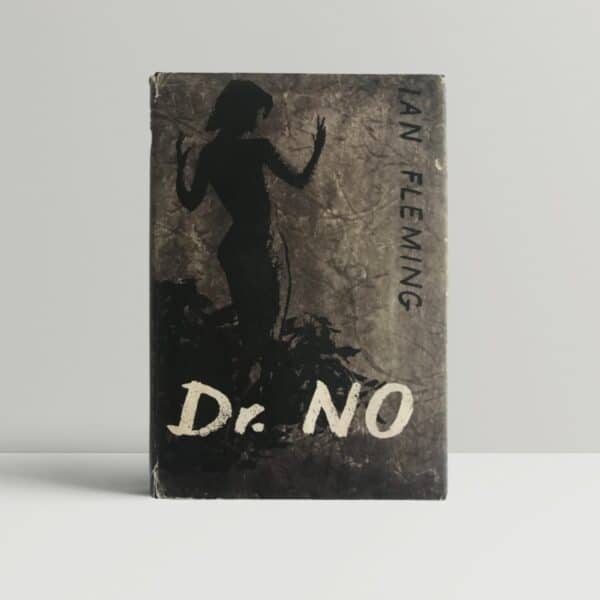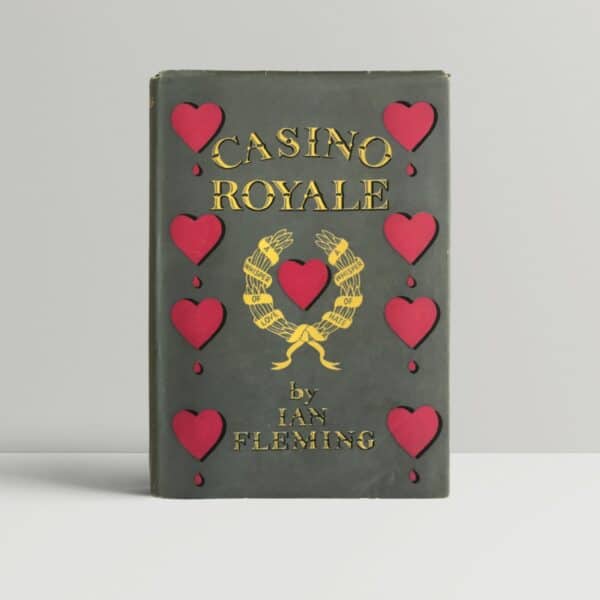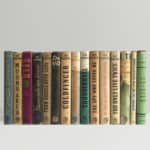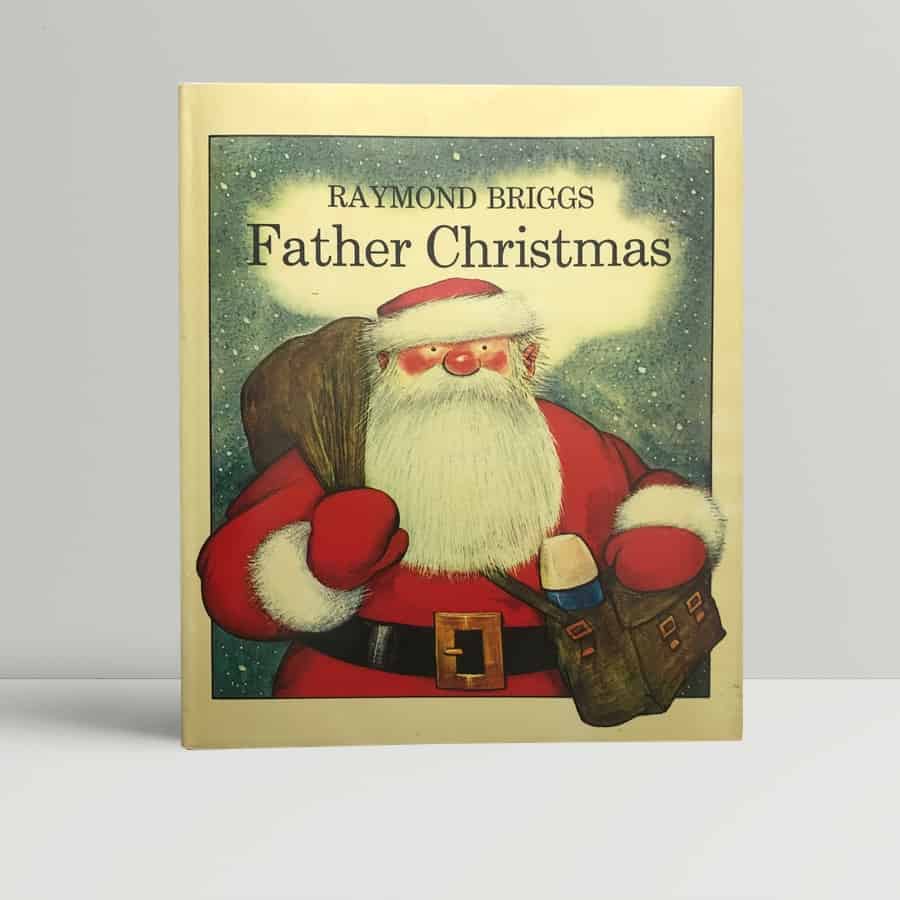Ian Fleming First Edition Collection – 17 Book Collection With 10 Inscribed by Fleming – All In Dust-Wrappers 1953-66
£400,000.00
An exciting collection of 17 books, with 10 of the collection signed and inscribed by Ian Fleming, as well as later (posthumous) titles signed by Sir Roger Moore, the ornithologist James Bond and actress Maud Adams (Octopussy).
Comprising: CASINO ROYALE: A first edition, first printing published by Cape in 1953. A near fine book without inscriptions. A little light pushing to the spine tips. No foxing. A lovely copy. SIGNED and INSCRIBED to the front endpaper by the Author – ‘To Lisl/Despite whose loving/care this book was/written/X/Ian/. In a very good, unclipped first issue dust wrapper with no overprinting to the front flap of the wrapper. Some light chipping to the head of the spine. A little light handling marks to the rear panel.
Ian Fleming first met Lisl Popper (then Lisa Jokl) at age nineteen during the “Golden time” at Kitzbuhel in Austria in 1926. She was eight years older than Fleming, and worked in a local cafe. Fleming soon became acquainted with Lisl and her friends at the cafe and her simple outdoor lifestyle appealed to Fleming immensely – skiing in winter, swimming and tennis in the summer. Another physical activity – sex – kept Fleming and Lisl very active as lovers and some years later he commented that despite the air of sexual liberation, he did show some reservation about the manner in which Austrian girls threw themselves at his young English body. Lisl and Fleming became lifelong friends, and in 1960, Fleming signed a copy of his latest James Bond instalment “For Your Eyes Only” (A collection of five short stories) to Lisl with the personal inscription “noch ein paar Eier fr Ostern!” (“yet another pair of eggs for Easter”). It is perhaps no coincidence that the female character in the fifth short story in the collection is named Lisl Baum. Upon Fleming’s death in 1964, he left Lisl £500 in his will. Lisl later said that “All the things said about Ian — his gloom, his melancholy, his solitariness — frankly amaze me. To all of us who knew him in Kitzbuhel he was exactly the opposite — Gay, care-free, terribly happy, the most exciting and vital sort of person. Not like an Englishman at all”. An extremely important association copy.
LIVE AND LET DIE: A first edition, first printing published by Cape in 1954. Inscribed by the Author on the front free end-paper: “To/ MW/ The faithful &/ true!/ from/ The Author”. With an additional ownership inscription and date (1954) of M J Williams on the front paste-down. The book is accompanied by the correct first state dust wrapper without the artist’s (Kenneth Lewis] credit on the front flap. Correctly priced at 10s.6d. net to both the front and rear flaps. There are a few very small internal neat repairs. Minor creasing to the edges and corners with a little light loss on the corners. Some light soiling to the rear panel as is usual.
Muriel Williams (often referred to as MJW or MW) was Fleming’s Assistant at Kemsley newspapers when he was the Foreign Manager. She was responsible for the day-to-day running of the Department in particular liaison with the “Stringers” who, hailing from far flung parts of the World, submitted stories for inclusion in the Kemsley Publications (including the Sunday Times).
The dust wrapper artist, Kenneth Lewis (who worked in the Art Department at Kemsley), remembers her well, commenting on her flat-chested appearance, strong and forceful personality, her use of bright red lipstick and that Fleming deferred to her. Fleming inscribed several of his other early novels to her, including Casino Royale and Moonraker. This book has been in private hands for many years.
MOONRAKER: A first edition, first printing published by Cape in 1955. A near fine book, inscribed by the author to the front end paper. The inscription reads – TO JOYCE / THE HAPPY GHOST / FROM / IAN FLEMING / 1955. Joyce Emerson (1921-1979), a journalist by trade, who worked at The Sunday Times during the 1950’s and 60’s. She befriended Fleming whilst working on the ‘Atticus’ team alongside him. Atticus was a weekly society gossip column, which Fleming joined in the autumn of 1953 (during the release time of his first novel ‘Casino Royale’). As the inscription suggests, Emerson would (almost certainly) have ghost-written many of the pieces carrying his name. The book is free of any owner names or inscriptions, with the correctly printed SHOOT found to page 10. The dust wrapper is in very good condition. There is the usual fading to the red flames found to the spine. Correctly priced at 10s.6d net to both the front and rear flaps.
An incredibly scarce title to acquire, signed and inscribed by the author and more so as the inscription includes Fleming’s full name as well as the year of publication.
DIAMONDS ARE FOREVER: A first edition, first printing published by Cape in 1956. A very good+ book without inscriptions. Some spotting to the prelims. Slight fading to the spine title. In a very good unclipped wrapper which has benefitted from some restoration to the bottom of the spine which is evident internally. Some rubbing and wear to the spine tips and corners. A little light soiling to the rear panel.
FROM RUSSIA WITH LOVE: A first edition, first printing published by Jonathan Cape in 1957. A very good book without inscriptions. Bound in the original black boards with silver titles on spine. Red rose and metallic gun to the front board. In the rare dust wrapper. The book has a little spotting within and some wear to the boards and edges. Sporadic spotting to the contents, with minor creasing to the rear board and little cracking to the rear pastedown. The dust wrapper is unclipped and original to the book. Some shallow v-shape loss to the spine ends. Exceptionally rare inscribed. The book is inscribed with the Author’s signed presentation inscription to the front endpaper, ‘To R. Singleton-Ward/ In (I hope)/Gratitude/ Ian Fleming/ 1957’/
The recipient Richard Singleton-Ward. Singleton-Ward was born in Droitwich at the turn of the century and studied as a masseur and physiotherapist, operating in the area until the 1940s. Singleton-Ward operated in Harley Street as a specialist physiotherapist in the 1950s and 1960s. This is borne out in his book, ‘My Two Hands Talk’, published by Christopher Johnson in the same year as ‘From Russia With Love’ – 1957. It is possible that Fleming used the book as background (as he had for Patrick Leigh Fermor’s, ‘Traveller’s Tree’ for ‘Live and Let Die’) for the health clinic scenes in the book of ‘Thunderball’, either introduced to the text by a member of the publishing house, or introduced to it by one of the man Harley Street specialists he used to visit. There is no coincidence perhaps that ‘Thunderball’ (published 4 years later) opens with Bond on the physiotherapist’s table having a massage. It is possible that Singleton-Ward was able to offer Fleming some background about the procedures. Fleming himself no doubt discovered the benefits for stress relief. The association in the presentation inscription suggests they were certainly good friends at the least. The rare use of Fleming’s full name and date in an inscription (1957) is evidence of this. With the early Bond books, he invariably preferred to use just his Christian name or the more formal “The Author”. Singleton-Ward’s address appears as 46 Portland Place W1 in 1965 (London Phone Book), but no trace after this with no mention after 1965 in the British General Chiropractors register/council. No death is registered in this name either.
Generally, it is thought that the success of James Bond in the USA was triggered by John F. Kennedy’s love of the character and the novels. The pair met on March 13, 1960. Fleming was visiting his friend, Mrs. Marion Leiter (having used the name for Bond’s American compatriot Felix) in Washington, DC. While Leiter was showing Fleming around Georgetown in her car, she saw the Kennedys walking by. She was due to dine with them that evening. She greeted the promenading Kennedys and asked if she could bring a guest over to dinner that night, telling them that, in fact, he was in her car right now. She introduced the two, Ian Fleming to Senator Kennedy, Senator Kennedy to Ian Fleming.
“James Bond?” said Kennedy, “But of course, by all means – do please come.” Fleming would later embellish this first encounter, instead claiming Kennedy said “THE Ian Fleming?” rather than the more recognisable name of his famous protagonist. Not only was Fleming indebted to Mrs. Leiter for this meeting, he owed to her the fact that Kennedy knew Bond at all. Five years earlier, when recovering from back pain, Leiter gave Kennedy a copy of Casino Royale to make his rest a little more exciting. The meeting itself had one particularly memorable episode. During the dinner party, Kennedy asked Fleming how he would depose Fidel Castro, a leader who would prove to be an irritant throughout Kennedy’s short term. The Bond author suggested humiliating Castro out of office. Fleming’s plan involved dropping fake dollar bills to disrupt the value of Cuban currency and distributing pamphlets which claimed that beards attracted radioactivity, which could lead to the impotence of the beard-wearer. Castro and his associates were famously bearded men, but they would now be shamed out of their facial hair. Thus, they’d appear like regular men, argued Fleming. They would either resign themselves, or be forced out by Cubans who realised their leaders were not as invulnerable as they claimed. The tone and intent behind Fleming’s plan has been debated, but it is most likely that he delivered it confidently, and entirely facetiously. Kennedy, renowned for his charm and humour, was amused by Fleming’s ridiculous proposal. Yet neither man could predict that the Kennedy administration would consider similarly ludicrous anti-Castro strategies, with one plot involving exploding seashells and another a poisoned cigar.
The relationship between John F. Kennedy and Ian Fleming proved thoroughly beneficial for each. JFK was a great fan of the Bond stories, and listed ‘From Russia With Love’ as number nine among his ten favourite books. Kennedy, if he was ever indebted to Fleming for enjoying his novels, paid it back in abundance. Following Kennedy’s endorsement of From Russia with Love in 1961, Fleming saw the sales of his book skyrocket, and he became the highest-selling crime author in the United States. It is believed that the last movie Kennedy viewed was From Russia with Love, the night before his death. Without Kennedy’s approval, it is thought that the James Bond literary franchise would have perhaps struggled in the USA. With Kennedy’s approval, not only the literary franchise boomed, but the movie franchise is the mammoth success we know today. The book is therefore exceptionally important to the James Bond canon. Presentation copies of ‘From Russia With Love’ are thus exceptionally rare.
DR NO: A first edition, first printing published by Cape in 1958. Book is the first issue rare variant WITHOUT the dancing lady silhouette of Honey Ryder. In very good+ condition, some spotting to the top edge and one name to the flap. Slight rise to the binding (printer’s errata) to pages 87-90). In a very good+ wrapper which is unclipped – some very light wear and creasing with a touch of loss to the spine ends – a lovely copy in wrapper.
GOLDFINGER: A first edition, first printing published by Cape in 1959. 8vo – original black cloth with skull motif, dust wrapper not price-clipped, author’s inscription and signature to Henry Cotton, ‘Peterffi’ armorial bookplate. A British Book Centre ticket neatly attached to the front flap of the dust wrapper. The dust wrapper is in near fine (or better) condition with only some extremely minor nicks to edges at creases and spine ends and a very light mark above the ‘E’ of Fleming.
An inscribed and signed copy of “Goldfinger” in superb condition. Ian Fleming has personally inscribed this first edition copy of “Goldfinger” to the British golfer, Sir Henry Cotton. Winning the Open in 1934, 1937 and 1938, Cotton is recognised as the leading British player of the time. Inscribed on the front free-endpaper: “To Henry Cotton, Who may be amused by pp.92-113, Ian Fleming”. The pages in question detail James Bond’s victory in a $10,000 grudge match with Goldfinger – Bond entering the match with a handicap of 9, the same as the author’s. The match in “Goldfinger” takes place at the fictional Royal St. Marks Golf Course, a location based on the Royal St. George’s at Sandwich, Kent, the club to which Fleming and Cotton were members. The game itself was based on a 1957 tournament at the Berkshire Golf Club, which partnered Ian Fleming with Open winner, Peter Thomson. Ian Fleming and Sir Henry Cotton had a good friendship – evidenced by the fact that Fleming has used his full name in the inscription, a trait usually seen when Fleming had a particularly close relationship with the recipient. “Goldfinger” dedicates a whole twenty-nine pages to this relationship and the game of golf, indicating how important both were to the author. Fleming was thrilled to appear as a subject in Henry Cotton’s “Golf Notes, published in “Farm and Country” in 1959. Cotton used photographs of golfers to illustrate particular golf swings and the problems caused by incorrectly positioned hands and feet. Ian Fleming can be seen here as ‘golfer 3’: “Celebrated author Ian Fleming is caught at a later point in his swing, and whilst his arms could be coming to a position of rest, both his feet are firmly anchored on his heels. In all three cases the body is nowhere near completely facing the hole; it is locked by the hips and ‘dead feet’.” In “Goldfinger”, Fleming has included a direct reference to Cotton’s observation regarding “that flat swing of yours” (p.102).
FOR YOUR EYES ONLY: A first edition, first printing published by Cape in 1960. A very good book with a stain to the page edge and one name and date to the head of the front endpaper. In a very good clipped wrapper, lightly faded to an orange. Some rubbing to the edges and corners.
THUNDERBALL: A first edition, first printing published by Cape in 1961. Very slight bumping to the boards and a touch of spotting to the top edge otherwise a near fine copy in like dust wrapper. Inscribed by the Author on the front endpaper: “To/ Wing Commander Dobson/ for/ his very kind help!/ from/ Ian Fleming”. Wing Commander Dobson was introduced to Fleming by Joan Saunders who ran the Writers and Speakers Research Agency. In “The Man with the Golden Typewriter” he is mentioned in a letter dated 5th September 1961 from Fleming to Saunders. A superb Association Copy with the – unusual – full use of Ian Fleming’s name. He tended to use more often than not the rather more formal “The Author” or the jocular “Ian” in his inscriptions. Exceptionally rare.
THE SPY WHO LOVED ME: A first edition, first printing published by Cape in 1962. A very good book without inscriptions, stained to the top of the spine and front board. In unclipped wrapper with corresponding staining. Small faded patch to the foot of the spine. INSCRIBED to the front endpaper: “To Claude, who holds the fort. From Ian.” Inscribed to Clude Taittinger, head of the Champagne family with whom Fleming was friendly; Taittinger received an advance copy of his next novel and had sponsored the Pinewood celebration to mark the first day’s filming of ‘From Russia, With Love’ 1st April 1963. Following his brother Francois’ untimely death in an accident, Claude stepped in to direct business from 1960 to 2005, steering the house to world renown. Based at Chateau de la Marquetterie, a former command post during World War I, the nature of the inscription would confirm this. PROVENANCE: From Fleming’s bibliographer, Jon Gilbert’s collection.
ON HER MAJESTY’S SECRET SERVICE: A first edition, first printing published by Jonathan Cape in 1963. A very good copy (marks to the boards in places) and light foxing to the page block edges in a VG+ slightly spine-darkened D/W. Inscribed by the Author on the front free end-paper: “To/ Joss/ from/ Ian/ 1963.” With the former owner’s name Pender and date in his own hand on the front paste-down.
Joss Pender was a member with Ian Fleming of the Royal St George’s Golf Club in Kent. Pender and Fleming were contemporaries at Eton. They died within a year of each other at relatively young ages. The families were subsequently to be linked through marriage and Denison-Penders and Flemings can still be found playing golf together at Sandwich to this day.
YOU ONLY LIVE TWICE: A first edition, first printing published by Cape in 1964. This is the first issue with ‘First published 1964’ to the copyright page. Publisher’s black cloth-effect paper over boards with silver titles to spine and Japanese characters in gilt to upper, bamboo patterned endpapers, in original pictorial dust-wrapper by Richard Chopping.
With presentation note in blue ink to flyleaf; To / Forshaw-san / from / Fleming-san [underline]. Very light handling only with one or two tiny nicks to the jacket; a fine copy.
This copy was presented by Ian Fleming to Aubrey Forshaw. The inscription incorporates the traditional Japanese honorary title ‘san’, used to show respect to the person being mentioned. In the novel, Tiger Tanaka, the head of the Japanese Secret Service, refers to 007 throughout as ‘Bondo-san’. Fleming used this device only when inscribing the book to his closest friends and colleagues. Examples presented in this way include: “Brilliant Chopping-san” [for the jacket artist Richard Chopping], “Dikko-san” [Richard Hughes, journalist and model for the character ‘Dikko Henderson’ in the novel], “Connolly-san” [author Cyril Connolly], and “From Fleming-san” [to Sunday Times editor Denis Hamilton, the dedicatee of Fleming’s Thrilling Cities]. The present ‘Forshaw-san’ is thus far unrecorded. Forshaw was Managing Director at Pan Books from 1952, following the death of its founder Alan Bott.The first Bond novel Casino Royale was published as a Pan edition in 1955 and each subsequent Bond novel would be published by Pan, as well as Fleming’s other three books The Diamond Smugglers, Thrilling Cities and Chitty-Chitty-Bang-Bang. In ‘The Man With the Golden Typewriter’, letters between Fleming and Forshaw are included on pages 319, 321, 322 and 371. It also appears that Fleming consulter Forshaw about the details of Bond’s Bentley Continental. The car was owned by Fleming and was driven and one by Bond in the film ‘Thunderball’. One of the letters from ‘The Man With The Golden Typewriter’ from Forshaw to Fleming is an invite to an awards dinner to celebrate the fact that ‘Casino Royale’ has sold over a million copies.
By the 1960’s Pan was the second-largest paperback publisher (after Penguin), largely thanks to the phenomenal global success of Ian Fleming and his James Bond series.
A superb association copy and a unique find.
THE MAN WITH THE GOLDEN GUN: A first edition, first printing published by Cape in 1965. A near fine book SIGNED by Sir Roger Moore to the title page without dedication – some rubbing to the spine tips and corners. In a very good unclipped wrapper with a little wear to the spine tips and corners and some browning to the spine and some spotting to the rear panel. Rare signed by Sir Roger.
Roger Moore, the suave English actor, portrayed James Bond in seven films, including “The Man with the Golden Gun” (1974). Filming in exotic locations like Thailand, the production faced challenges due to political unrest. Moore’s charm and wit, epitomising the Bond character, shone through despite difficulties. The film featured iconic sequences, including the car barrel-roll stunt. Moore’s performance, blending humour and action, solidified his place as one of the most beloved Bonds. “The Man with the Golden Gun” remains a testament to Moore’s enduring legacy as 007 and the enduring allure of the James Bond franchise.
OCTOPUSSY: A first edition, first printing published by Cape in 1966. SIGNED by Maud Adams, actress who played ‘Octopussy’ to the title page. A near Fien book in near fine clipped wrapper with a little rubbing to the corners and edges.
“Octopussy”, a 1983 James Bond film featuring Swedish actress Maud Adams in a pivotal role. Adams portrays the titular character, Octopussy, a wealthy and enigmatic businesswoman with a complex past. The film follows James Bond, played by Roger Moore, as he investigates a plot involving stolen Soviet treasures, a renegade general, and a scheme to detonate a nuclear bomb. Octopussy becomes involved in the intrigue when Bond discovers that her smuggling operation is being used as a cover for the villain’s plans. Adams brings a captivating presence to the role of Octopussy, balancing charm, intelligence, and strength. Her character serves as both ally and love interest to Bond, adding depth to their relationship dynamics. Adams’ performance contributes to the film’s success, with her character becoming one of the more memorable and iconic figures in the James Bond franchise.
THRILLING CITIES: A first edition, first printing published by Cape in 1963. A very good/near fine book in like wrapper which is not clipped and has the usual fading to the spine and wear to the spine tips. Edges browned. Now housed in custom-made solander box mirroring the boards of the book itself.
Inscribed on the front endpaper by Fleming: “To Una/Who did so much of/the real work!/from/Ian Fleming”
The inscription is a warm one and Una is mentioned within the text of the book (”Take down a letter Miss Trueblood” – p. 28).
Una Trueblood was Fleming’s secretary at Kemsley. She typed up the television treatment that Fleming later developed into the novel Doctor No and, like many of Fleming’s acquaintances, she gives her name to a character in the novel: Mary Trueblood, secretary to the MI6 station in Jamaica. In the story, Mary Trueblood was a former Chief Officer WRNS and secretary to John Strangways, the head of the British Secret Service’s Caribbean station based in Jamaica. After assassinating Strangways for prying into Dr. Julius No’s business, his killers proceed to the station and murder Trueblood during her scheduled contact with London. Both she and Strangways are placed in a weighted coffin and dumped in the Mona Reservoir; sinking into a fifty-fathom grave as the station and its records burn to the ground. After an official investigation is launched into their disappearance, the head of the Secret Service, M, noting her good looks, floats the idea that they might have run off together.
Una Trueblood, a real-life Miss Moneypenny, worked for over ten years as Fleming’s secretary at The Sunday Times. She was known as ‘a demon typist’ and typed the manuscripts of Fleming’s Bond novels upon his return from Jamaica each year. Trueblood was mentioned in Fleming’s ‘Thrilling Cities’ and was known by Fleming for her professionalism and fastidiousness. Una once spoke of her boss’s move into literature: “He always said he only wrote Casino Royale, the first Bond book, because he was on the plane to Jamaica and he read such a bad, boring thriller that he thought he could do better himself.”
Inscribed copies of Bond books are rare, but inscribed copies which connect the inscribee to a character within the Bond literature are exceptionally scarce.
JAMES BOND – BIRDS OF THE WEST INDIES: A pair of books, comprising: James Bond – A Field Guide to Birds of the West Indies – Macmillan 1947. SIGNED BY JAMES BOND directly on title page without dedication. A very good book in original full brown cloth, map endpapers, 257 pages, illustrated. In very good dust wrapper with wear, chipping, and short closed tear to the front panel.
Mary Wickham Bond – How 007 Got His Names – A near fine book SIGNED and inscribed on the front endpaper by Bond, ‘To Essie/from her long-lost/”Squidge’/alias/Mary Wickham Bond/July 26 1966/The Stafford/London. In near fine unclipped wrapper, a trifle rubbed to corners
Bond was an American ornithologist, specialising in birds of the Caribbean and while living in Jamaica, met and befriended Ian Fleming, who was also an avid bird watcher. Fleming liked and decided James Bond was the name he had been searching for and used Bond’s name for the protagonist of his first novel Casino Royale and the subsequent secret service series featuring James Bond.
Please do contact us for further details and photos of this rare set
(We don't keep all of our stock in the shop, so send us an email if you're planning a trip to see a particular author or book.)
- Description
Description
An exciting collection of 17 books, with 10 of the collection signed and inscribed by Ian Fleming, as well as later (posthumous) titles signed by Sir Roger Moore, the ornithologist James Bond and actress Maud Adams (Octopussy).
Comprising: CASINO ROYALE: A first edition, first printing published by Cape in 1953. A near fine book without inscriptions. A little light pushing to the spine tips. No foxing. A lovely copy. SIGNED and INSCRIBED to the front endpaper by the Author – ‘To Lisl/Despite whose loving/care this book was/written/X/Ian/. In a very good, unclipped first issue dust wrapper with no overprinting to the front flap of the wrapper. Some light chipping to the head of the spine. A little light handling marks to the rear panel.
Ian Fleming first met Lisl Popper (then Lisa Jokl) at age nineteen during the “Golden time” at Kitzbuhel in Austria in 1926. She was eight years older than Fleming, and worked in a local cafe. Fleming soon became acquainted with Lisl and her friends at the cafe and her simple outdoor lifestyle appealed to Fleming immensely – skiing in winter, swimming and tennis in the summer. Another physical activity – sex – kept Fleming and Lisl very active as lovers and some years later he commented that despite the air of sexual liberation, he did show some reservation about the manner in which Austrian girls threw themselves at his young English body. Lisl and Fleming became lifelong friends, and in 1960, Fleming signed a copy of his latest James Bond instalment “For Your Eyes Only” (A collection of five short stories) to Lisl with the personal inscription “noch ein paar Eier fr Ostern!” (“yet another pair of eggs for Easter”). It is perhaps no coincidence that the female character in the fifth short story in the collection is named Lisl Baum. Upon Fleming’s death in 1964, he left Lisl £500 in his will. Lisl later said that “All the things said about Ian — his gloom, his melancholy, his solitariness — frankly amaze me. To all of us who knew him in Kitzbuhel he was exactly the opposite — Gay, care-free, terribly happy, the most exciting and vital sort of person. Not like an Englishman at all”. An extremely important association copy.
LIVE AND LET DIE: A first edition, first printing published by Cape in 1954. Inscribed by the Author on the front free end-paper: “To/ MW/ The faithful &/ true!/ from/ The Author”. With an additional ownership inscription and date (1954) of M J Williams on the front paste-down. The book is accompanied by the correct first state dust wrapper without the artist’s (Kenneth Lewis] credit on the front flap. Correctly priced at 10s.6d. net to both the front and rear flaps. There are a few very small internal neat repairs. Minor creasing to the edges and corners with a little light loss on the corners. Some light soiling to the rear panel as is usual.
Muriel Williams (often referred to as MJW or MW) was Fleming’s Assistant at Kemsley newspapers when he was the Foreign Manager. She was responsible for the day-to-day running of the Department in particular liaison with the “Stringers” who, hailing from far flung parts of the World, submitted stories for inclusion in the Kemsley Publications (including the Sunday Times).
The dust wrapper artist, Kenneth Lewis (who worked in the Art Department at Kemsley), remembers her well, commenting on her flat-chested appearance, strong and forceful personality, her use of bright red lipstick and that Fleming deferred to her. Fleming inscribed several of his other early novels to her, including Casino Royale and Moonraker. This book has been in private hands for many years.
MOONRAKER: A first edition, first printing published by Cape in 1955. A near fine book, inscribed by the author to the front end paper. The inscription reads – TO JOYCE / THE HAPPY GHOST / FROM / IAN FLEMING / 1955. Joyce Emerson (1921-1979), a journalist by trade, who worked at The Sunday Times during the 1950’s and 60’s. She befriended Fleming whilst working on the ‘Atticus’ team alongside him. Atticus was a weekly society gossip column, which Fleming joined in the autumn of 1953 (during the release time of his first novel ‘Casino Royale’). As the inscription suggests, Emerson would (almost certainly) have ghost-written many of the pieces carrying his name. The book is free of any owner names or inscriptions, with the correctly printed SHOOT found to page 10. The dust wrapper is in very good condition. There is the usual fading to the red flames found to the spine. Correctly priced at 10s.6d net to both the front and rear flaps.
An incredibly scarce title to acquire, signed and inscribed by the author and more so as the inscription includes Fleming’s full name as well as the year of publication.
DIAMONDS ARE FOREVER: A first edition, first printing published by Cape in 1956. A very good+ book without inscriptions. Some spotting to the prelims. Slight fading to the spine title. In a very good unclipped wrapper which has benefitted from some restoration to the bottom of the spine which is evident internally. Some rubbing and wear to the spine tips and corners. A little light soiling to the rear panel.
FROM RUSSIA WITH LOVE: A first edition, first printing published by Jonathan Cape in 1957. A very good book without inscriptions. Bound in the original black boards with silver titles on spine. Red rose and metallic gun to the front board. In the rare dust wrapper. The book has a little spotting within and some wear to the boards and edges. Sporadic spotting to the contents, with minor creasing to the rear board and little cracking to the rear pastedown. The dust wrapper is unclipped and original to the book. Some shallow v-shape loss to the spine ends. Exceptionally rare inscribed. The book is inscribed with the Author’s signed presentation inscription to the front endpaper, ‘To R. Singleton-Ward/ In (I hope)/Gratitude/ Ian Fleming/ 1957’/
The recipient Richard Singleton-Ward. Singleton-Ward was born in Droitwich at the turn of the century and studied as a masseur and physiotherapist, operating in the area until the 1940s. Singleton-Ward operated in Harley Street as a specialist physiotherapist in the 1950s and 1960s. This is borne out in his book, ‘My Two Hands Talk’, published by Christopher Johnson in the same year as ‘From Russia With Love’ – 1957. It is possible that Fleming used the book as background (as he had for Patrick Leigh Fermor’s, ‘Traveller’s Tree’ for ‘Live and Let Die’) for the health clinic scenes in the book of ‘Thunderball’, either introduced to the text by a member of the publishing house, or introduced to it by one of the man Harley Street specialists he used to visit. There is no coincidence perhaps that ‘Thunderball’ (published 4 years later) opens with Bond on the physiotherapist’s table having a massage. It is possible that Singleton-Ward was able to offer Fleming some background about the procedures. Fleming himself no doubt discovered the benefits for stress relief. The association in the presentation inscription suggests they were certainly good friends at the least. The rare use of Fleming’s full name and date in an inscription (1957) is evidence of this. With the early Bond books, he invariably preferred to use just his Christian name or the more formal “The Author”. Singleton-Ward’s address appears as 46 Portland Place W1 in 1965 (London Phone Book), but no trace after this with no mention after 1965 in the British General Chiropractors register/council. No death is registered in this name either.
Generally, it is thought that the success of James Bond in the USA was triggered by John F. Kennedy’s love of the character and the novels. The pair met on March 13, 1960. Fleming was visiting his friend, Mrs. Marion Leiter (having used the name for Bond’s American compatriot Felix) in Washington, DC. While Leiter was showing Fleming around Georgetown in her car, she saw the Kennedys walking by. She was due to dine with them that evening. She greeted the promenading Kennedys and asked if she could bring a guest over to dinner that night, telling them that, in fact, he was in her car right now. She introduced the two, Ian Fleming to Senator Kennedy, Senator Kennedy to Ian Fleming.
“James Bond?” said Kennedy, “But of course, by all means – do please come.” Fleming would later embellish this first encounter, instead claiming Kennedy said “THE Ian Fleming?” rather than the more recognisable name of his famous protagonist. Not only was Fleming indebted to Mrs. Leiter for this meeting, he owed to her the fact that Kennedy knew Bond at all. Five years earlier, when recovering from back pain, Leiter gave Kennedy a copy of Casino Royale to make his rest a little more exciting. The meeting itself had one particularly memorable episode. During the dinner party, Kennedy asked Fleming how he would depose Fidel Castro, a leader who would prove to be an irritant throughout Kennedy’s short term. The Bond author suggested humiliating Castro out of office. Fleming’s plan involved dropping fake dollar bills to disrupt the value of Cuban currency and distributing pamphlets which claimed that beards attracted radioactivity, which could lead to the impotence of the beard-wearer. Castro and his associates were famously bearded men, but they would now be shamed out of their facial hair. Thus, they’d appear like regular men, argued Fleming. They would either resign themselves, or be forced out by Cubans who realised their leaders were not as invulnerable as they claimed. The tone and intent behind Fleming’s plan has been debated, but it is most likely that he delivered it confidently, and entirely facetiously. Kennedy, renowned for his charm and humour, was amused by Fleming’s ridiculous proposal. Yet neither man could predict that the Kennedy administration would consider similarly ludicrous anti-Castro strategies, with one plot involving exploding seashells and another a poisoned cigar.
The relationship between John F. Kennedy and Ian Fleming proved thoroughly beneficial for each. JFK was a great fan of the Bond stories, and listed ‘From Russia With Love’ as number nine among his ten favourite books. Kennedy, if he was ever indebted to Fleming for enjoying his novels, paid it back in abundance. Following Kennedy’s endorsement of From Russia with Love in 1961, Fleming saw the sales of his book skyrocket, and he became the highest-selling crime author in the United States. It is believed that the last movie Kennedy viewed was From Russia with Love, the night before his death. Without Kennedy’s approval, it is thought that the James Bond literary franchise would have perhaps struggled in the USA. With Kennedy’s approval, not only the literary franchise boomed, but the movie franchise is the mammoth success we know today. The book is therefore exceptionally important to the James Bond canon. Presentation copies of ‘From Russia With Love’ are thus exceptionally rare.
DR NO: A first edition, first printing published by Cape in 1958. Book is the first issue rare variant WITHOUT the dancing lady silhouette of Honey Ryder. In very good+ condition, some spotting to the top edge and one name to the flap. Slight rise to the binding (printer’s errata) to pages 87-90). In a very good+ wrapper which is unclipped – some very light wear and creasing with a touch of loss to the spine ends – a lovely copy in wrapper.
GOLDFINGER: A first edition, first printing published by Cape in 1959. 8vo – original black cloth with skull motif, dust wrapper not price-clipped, author’s inscription and signature to Henry Cotton, ‘Peterffi’ armorial bookplate. A British Book Centre ticket neatly attached to the front flap of the dust wrapper. The dust wrapper is in near fine (or better) condition with only some extremely minor nicks to edges at creases and spine ends and a very light mark above the ‘E’ of Fleming.
An inscribed and signed copy of “Goldfinger” in superb condition. Ian Fleming has personally inscribed this first edition copy of “Goldfinger” to the British golfer, Sir Henry Cotton. Winning the Open in 1934, 1937 and 1938, Cotton is recognised as the leading British player of the time. Inscribed on the front free-endpaper: “To Henry Cotton, Who may be amused by pp.92-113, Ian Fleming”. The pages in question detail James Bond’s victory in a $10,000 grudge match with Goldfinger – Bond entering the match with a handicap of 9, the same as the author’s. The match in “Goldfinger” takes place at the fictional Royal St. Marks Golf Course, a location based on the Royal St. George’s at Sandwich, Kent, the club to which Fleming and Cotton were members. The game itself was based on a 1957 tournament at the Berkshire Golf Club, which partnered Ian Fleming with Open winner, Peter Thomson. Ian Fleming and Sir Henry Cotton had a good friendship – evidenced by the fact that Fleming has used his full name in the inscription, a trait usually seen when Fleming had a particularly close relationship with the recipient. “Goldfinger” dedicates a whole twenty-nine pages to this relationship and the game of golf, indicating how important both were to the author. Fleming was thrilled to appear as a subject in Henry Cotton’s “Golf Notes, published in “Farm and Country” in 1959. Cotton used photographs of golfers to illustrate particular golf swings and the problems caused by incorrectly positioned hands and feet. Ian Fleming can be seen here as ‘golfer 3’: “Celebrated author Ian Fleming is caught at a later point in his swing, and whilst his arms could be coming to a position of rest, both his feet are firmly anchored on his heels. In all three cases the body is nowhere near completely facing the hole; it is locked by the hips and ‘dead feet’.” In “Goldfinger”, Fleming has included a direct reference to Cotton’s observation regarding “that flat swing of yours” (p.102).
FOR YOUR EYES ONLY: A first edition, first printing published by Cape in 1960. A very good book with a stain to the page edge and one name and date to the head of the front endpaper. In a very good clipped wrapper, lightly faded to an orange. Some rubbing to the edges and corners.
THUNDERBALL: A first edition, first printing published by Cape in 1961. Very slight bumping to the boards and a touch of spotting to the top edge otherwise a near fine copy in like dust wrapper. Inscribed by the Author on the front endpaper: “To/ Wing Commander Dobson/ for/ his very kind help!/ from/ Ian Fleming”. Wing Commander Dobson was introduced to Fleming by Joan Saunders who ran the Writers and Speakers Research Agency. In “The Man with the Golden Typewriter” he is mentioned in a letter dated 5th September 1961 from Fleming to Saunders. A superb Association Copy with the – unusual – full use of Ian Fleming’s name. He tended to use more often than not the rather more formal “The Author” or the jocular “Ian” in his inscriptions. Exceptionally rare.
THE SPY WHO LOVED ME: A first edition, first printing published by Cape in 1962. A very good book without inscriptions, stained to the top of the spine and front board. In unclipped wrapper with corresponding staining. Small faded patch to the foot of the spine. INSCRIBED to the front endpaper: “To Claude, who holds the fort. From Ian.” Inscribed to Clude Taittinger, head of the Champagne family with whom Fleming was friendly; Taittinger received an advance copy of his next novel and had sponsored the Pinewood celebration to mark the first day’s filming of ‘From Russia, With Love’ 1st April 1963. Following his brother Francois’ untimely death in an accident, Claude stepped in to direct business from 1960 to 2005, steering the house to world renown. Based at Chateau de la Marquetterie, a former command post during World War I, the nature of the inscription would confirm this. PROVENANCE: From Fleming’s bibliographer, Jon Gilbert’s collection.
ON HER MAJESTY’S SECRET SERVICE: A first edition, first printing published by Jonathan Cape in 1963. A very good copy (marks to the boards in places) and light foxing to the page block edges in a VG+ slightly spine-darkened D/W. Inscribed by the Author on the front free end-paper: “To/ Joss/ from/ Ian/ 1963.” With the former owner’s name Pender and date in his own hand on the front paste-down.
Joss Pender was a member with Ian Fleming of the Royal St George’s Golf Club in Kent. Pender and Fleming were contemporaries at Eton. They died within a year of each other at relatively young ages. The families were subsequently to be linked through marriage and Denison-Penders and Flemings can still be found playing golf together at Sandwich to this day.
YOU ONLY LIVE TWICE: A first edition, first printing published by Cape in 1964. This is the first issue with ‘First published 1964’ to the copyright page. Publisher’s black cloth-effect paper over boards with silver titles to spine and Japanese characters in gilt to upper, bamboo patterned endpapers, in original pictorial dust-wrapper by Richard Chopping.
With presentation note in blue ink to flyleaf; To / Forshaw-san / from / Fleming-san [underline]. Very light handling only with one or two tiny nicks to the jacket; a fine copy.
This copy was presented by Ian Fleming to Aubrey Forshaw. The inscription incorporates the traditional Japanese honorary title ‘san’, used to show respect to the person being mentioned. In the novel, Tiger Tanaka, the head of the Japanese Secret Service, refers to 007 throughout as ‘Bondo-san’. Fleming used this device only when inscribing the book to his closest friends and colleagues. Examples presented in this way include: “Brilliant Chopping-san” [for the jacket artist Richard Chopping], “Dikko-san” [Richard Hughes, journalist and model for the character ‘Dikko Henderson’ in the novel], “Connolly-san” [author Cyril Connolly], and “From Fleming-san” [to Sunday Times editor Denis Hamilton, the dedicatee of Fleming’s Thrilling Cities]. The present ‘Forshaw-san’ is thus far unrecorded. Forshaw was Managing Director at Pan Books from 1952, following the death of its founder Alan Bott.The first Bond novel Casino Royale was published as a Pan edition in 1955 and each subsequent Bond novel would be published by Pan, as well as Fleming’s other three books The Diamond Smugglers, Thrilling Cities and Chitty-Chitty-Bang-Bang. In ‘The Man With the Golden Typewriter’, letters between Fleming and Forshaw are included on pages 319, 321, 322 and 371. It also appears that Fleming consulter Forshaw about the details of Bond’s Bentley Continental. The car was owned by Fleming and was driven and one by Bond in the film ‘Thunderball’. One of the letters from ‘The Man With The Golden Typewriter’ from Forshaw to Fleming is an invite to an awards dinner to celebrate the fact that ‘Casino Royale’ has sold over a million copies.
By the 1960’s Pan was the second-largest paperback publisher (after Penguin), largely thanks to the phenomenal global success of Ian Fleming and his James Bond series.
A superb association copy and a unique find.
THE MAN WITH THE GOLDEN GUN: A first edition, first printing published by Cape in 1965. A near fine book SIGNED by Sir Roger Moore to the title page without dedication – some rubbing to the spine tips and corners. In a very good unclipped wrapper with a little wear to the spine tips and corners and some browning to the spine and some spotting to the rear panel. Rare signed by Sir Roger.
Roger Moore, the suave English actor, portrayed James Bond in seven films, including “The Man with the Golden Gun” (1974). Filming in exotic locations like Thailand, the production faced challenges due to political unrest. Moore’s charm and wit, epitomising the Bond character, shone through despite difficulties. The film featured iconic sequences, including the car barrel-roll stunt. Moore’s performance, blending humour and action, solidified his place as one of the most beloved Bonds. “The Man with the Golden Gun” remains a testament to Moore’s enduring legacy as 007 and the enduring allure of the James Bond franchise.
OCTOPUSSY: A first edition, first printing published by Cape in 1966. SIGNED by Maud Adams, actress who played ‘Octopussy’ to the title page. A near Fien book in near fine clipped wrapper with a little rubbing to the corners and edges.
“Octopussy”, a 1983 James Bond film featuring Swedish actress Maud Adams in a pivotal role. Adams portrays the titular character, Octopussy, a wealthy and enigmatic businesswoman with a complex past. The film follows James Bond, played by Roger Moore, as he investigates a plot involving stolen Soviet treasures, a renegade general, and a scheme to detonate a nuclear bomb. Octopussy becomes involved in the intrigue when Bond discovers that her smuggling operation is being used as a cover for the villain’s plans. Adams brings a captivating presence to the role of Octopussy, balancing charm, intelligence, and strength. Her character serves as both ally and love interest to Bond, adding depth to their relationship dynamics. Adams’ performance contributes to the film’s success, with her character becoming one of the more memorable and iconic figures in the James Bond franchise.
THRILLING CITIES: A first edition, first printing published by Cape in 1963. A very good/near fine book in like wrapper which is not clipped and has the usual fading to the spine and wear to the spine tips. Edges browned. Now housed in custom-made solander box mirroring the boards of the book itself.
Inscribed on the front endpaper by Fleming: “To Una/Who did so much of/the real work!/from/Ian Fleming”
The inscription is a warm one and Una is mentioned within the text of the book (”Take down a letter Miss Trueblood” – p. 28).
Una Trueblood was Fleming’s secretary at Kemsley. She typed up the television treatment that Fleming later developed into the novel Doctor No and, like many of Fleming’s acquaintances, she gives her name to a character in the novel: Mary Trueblood, secretary to the MI6 station in Jamaica. In the story, Mary Trueblood was a former Chief Officer WRNS and secretary to John Strangways, the head of the British Secret Service’s Caribbean station based in Jamaica. After assassinating Strangways for prying into Dr. Julius No’s business, his killers proceed to the station and murder Trueblood during her scheduled contact with London. Both she and Strangways are placed in a weighted coffin and dumped in the Mona Reservoir; sinking into a fifty-fathom grave as the station and its records burn to the ground. After an official investigation is launched into their disappearance, the head of the Secret Service, M, noting her good looks, floats the idea that they might have run off together.
Una Trueblood, a real-life Miss Moneypenny, worked for over ten years as Fleming’s secretary at The Sunday Times. She was known as ‘a demon typist’ and typed the manuscripts of Fleming’s Bond novels upon his return from Jamaica each year. Trueblood was mentioned in Fleming’s ‘Thrilling Cities’ and was known by Fleming for her professionalism and fastidiousness. Una once spoke of her boss’s move into literature: “He always said he only wrote Casino Royale, the first Bond book, because he was on the plane to Jamaica and he read such a bad, boring thriller that he thought he could do better himself.”
Inscribed copies of Bond books are rare, but inscribed copies which connect the inscribee to a character within the Bond literature are exceptionally scarce.
JAMES BOND – BIRDS OF THE WEST INDIES: A pair of books, comprising: James Bond – A Field Guide to Birds of the West Indies – Macmillan 1947. SIGNED BY JAMES BOND directly on title page without dedication. A very good book in original full brown cloth, map endpapers, 257 pages, illustrated. In very good dust wrapper with wear, chipping, and short closed tear to the front panel.
Mary Wickham Bond – How 007 Got His Names – A near fine book SIGNED and inscribed on the front endpaper by Bond, ‘To Essie/from her long-lost/”Squidge’/alias/Mary Wickham Bond/July 26 1966/The Stafford/London. In near fine unclipped wrapper, a trifle rubbed to corners
Bond was an American ornithologist, specialising in birds of the Caribbean and while living in Jamaica, met and befriended Ian Fleming, who was also an avid bird watcher. Fleming liked and decided James Bond was the name he had been searching for and used Bond’s name for the protagonist of his first novel Casino Royale and the subsequent secret service series featuring James Bond.
Please do contact us for further details and photos of this rare set

